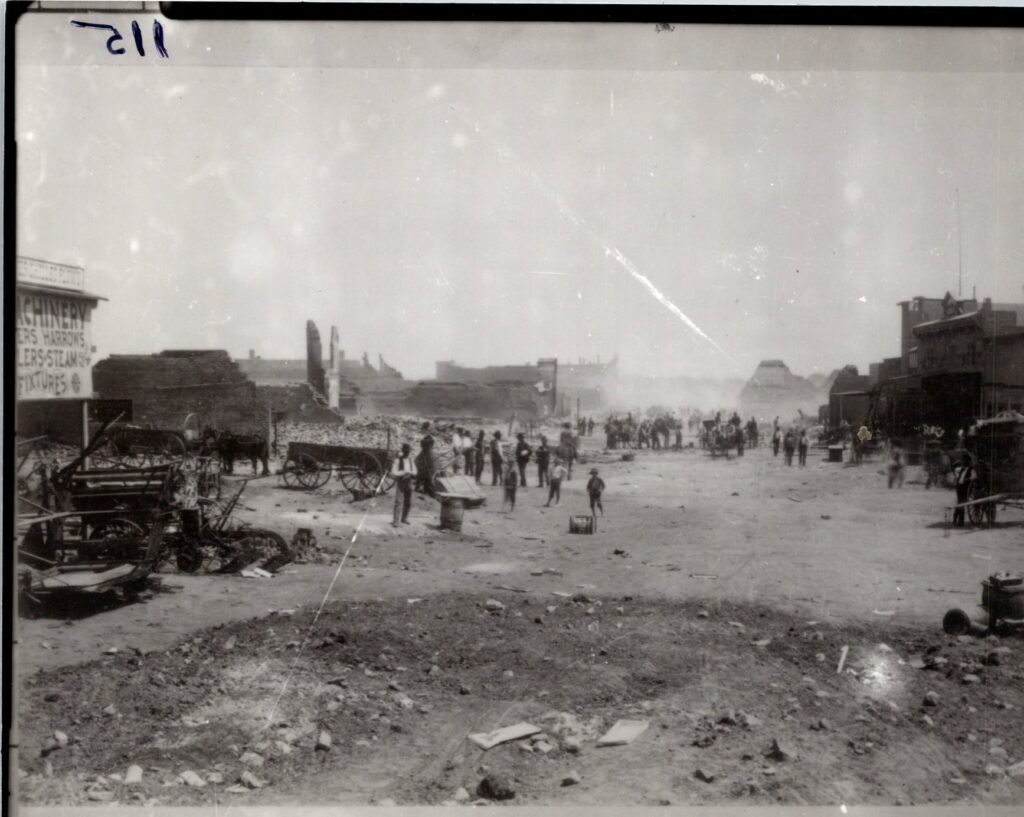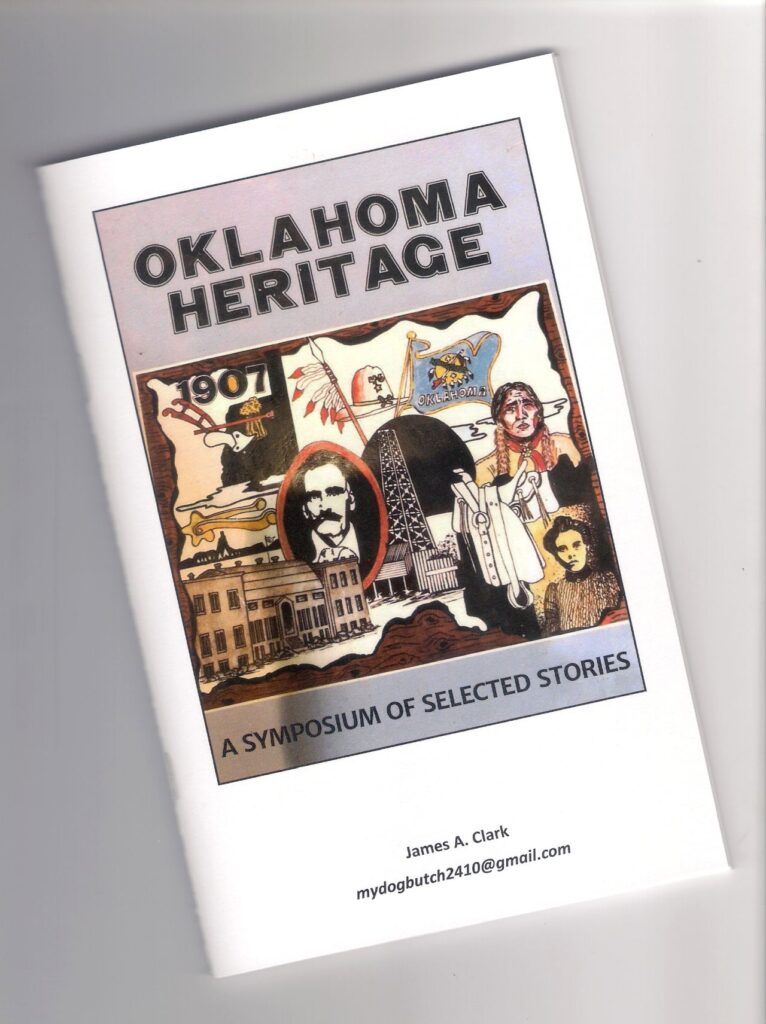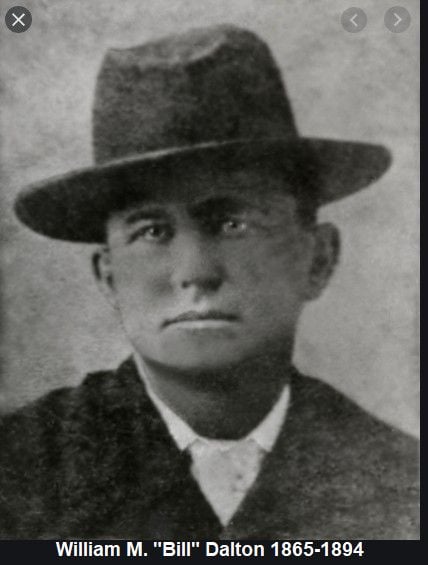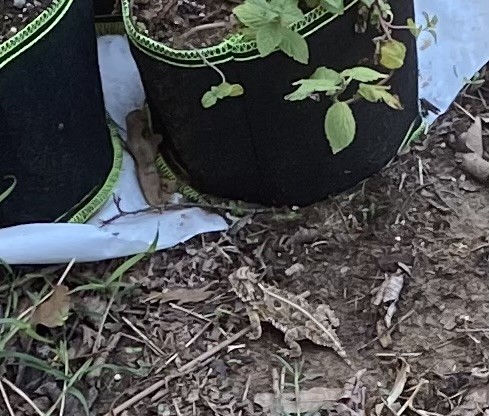
It was in Harper's livery stable on North Caddo, that the Great Fire of 1895 started, wiping out or damaging all buildings in Ardmore's business district. 46 structures were destroyed and nine others sustained damage. The fire burn through the area bound by A Street northwest, North Caddo, Broadway and Main Street, taking with it the city's best buildings, including the Anderson-Burch Opera House, the First National Bank, which was the first brick building to be built in Ardmore, the Klosky Opera House, the Ardmoreite building and the Pennington building. Prisoners in the federal jail on Mill Street were moved to the Broadway Baptist Church and then to a seed House near Santa Fe tracks. In the first hour of the conflagration, the three public wells on Main Street went dry. For Ardmore, it was the call to start over with better means of firefighting. John L. Galt and J.S. Hammer took the lead in crusading for firefighting equipment, and although the city's merchants had been hit hard, some wiped out, by the disaster, the necessary funds were raised to purchase a fire engine, 600 feet of hose and a hose cart. A volunteer fire department, with John S. O'Mealey as fire chief, was organized and charged with the responsibility of selecting firefighting equipment for the town. While wrangling and indecision delayed the selection, another fire broke out east of the Santa Fe tracks and the argument came to an end in 1897, funds were raised for necessary equipment and three large cisterns to be dug at the various points on Main Street, to be used for water storage in case of another fire. -Territory Town: The Ardmore Story by Sally M. Gray

Why Taking An Indian Bride Was So Lucrative
Oklahoma Heritage: A Symposium of Selected Stories
by James A. Clark
In 1884, Dr Theophilus H. East (1852-1917) married Chickasaw widow Francis Colbert (1831-1913) who was 21 years older than him. Dr East was tired of his older wife but became incensed when she left him in 1887. This immediately led to a pistol fight between him and her new companion, a man named Tom little. Tom died of a head wound but the doctor was only grazed by one of Tom’s bullets. Dr East was acquitted of the murder since the jury believed he defended himself after Tom shot first. Note: Dr East was also charged in 1893 with killing a witness who saw a murder by desperado Clyde Maddox. He was acquitted of this killing as well.
Shortly after the gunfight, Dr East found his marriage under U.S. law exclude him from owning any Chickasaw land as he wouldn’t be considered a tribal member. As a result, he coerced Francis into marrying him again under Chickasaw law in 1888. Note: Since so many white men were marrying Indian women mainly for access to land, the price of an Indian marriage license went up from $25 to over $1,000 in order to dissuade this practice!
In 1892, the doctor divorced Francis and married a white woman named Teresa M. Smithers the following year under U.S. law. Apparently, in an attempt for his new wife to become a tribal member, they remarried under Chickasaw law on August 5, 1897 but this was disputed by the Chickasaw tribe. The doctor was about to marry for the 9th time but his eighth wife vowed she would stop him.
A true story.

When Bill Dalton Was A Scourge
“They’re bringing Dalton in on a wagon.” That was the news which reached an excited but relieved Ardmore back in 1894. Bill Dalton had been killed.
For weeks in the spring of that year officers had known that a band of thieves had centered headquarters in the country between Healdton and Elk (now Pooleville), Oklahoma and the section had been closely scanned since the big bank robbery by the Dalton Gang at Longview, Texas.
A man who called himself Herbert Wallace, and two strange women, came to Ardmore on Thursday, June 7th and soon they poured some $200 into the merchants’ tills. The women gave their names as Mrs. Brown and Miss Pruitt.
As the trio moved about, watchful deputies shadowed them and nabbed Wallace at the express office where he obtained a package. The package contained three gallons of whisky and, in the style of the day, Wallace was arrested on a charge of “introducing.” He and his companions were jailed.
The officers found that the visitors had bought an unusual amount of rifle cartridges, dress goods, jewelry, groceries and a complete camping outfit.
Almost at once Deputy Lindsey and Deputy W. B. Freeman, who had made this arrest, formed a posse. The members were Los Hart, J. H. Leatherman, C. R. Denton, J. M. Reynolds, D. E. Booker, W. C. Freeman, W. H. Glover and E. W. Roberts.
The group rode all night and arrived at Wallace’s house near Elk (Pooleville) about 8 a.m. the next day. The deputies divided into two groups, each taking a ridge from which the surrounding area could be observed.
A couple of times during the study of the surroundings the two groups mistook each other for intruders and a tragedy of the two squads firing on each other narrowly was averted.
Soon children came out of the house to play and women appeared in the yard. A slow advance was made by the deputies and within 200 yards of the house a woman driving a herd of calves come upon one of the squads.
After her first surprise she beat a hasty retreat to the house. The officers closed in just as Dalton sprang through a rear window right under the barrel of Hart’s gun.
“Surrender,” Hart called.
The fugitive had a different idea and dashed for the nearby timber. Hart gave Dalton another chance to give up, but the outlaw only reached for his gun. Hart fired a shot and a bullet went straight into Dalton who crumpled and made but one convulsive movement, to turn over from his face to his back.
Lindsey spied an armed figure at a window and fired, but the figure disappeared and was not located, Lindsey ordered the women to leave the house and they took shelter in the barn. Officers entered but found the place uninhibited. Everything was in order. A money sack with the brand of the Longview bank was found and about $1 ,700 recovered. Money lay about with no attempt of concealment.
On Dalton was found $285. His identity was established by a pack of letters found in the trunk of Mrs. Dalton, alias Brown.
As the wagon bearing the body of Dalton come to a point about five miles from town the cortege come upon Mrs. Dalton and Miss Pruitt who had been returning to the hideout.
Mrs. Dalton denied knowing the dead man but later, when her composure broke, she admitted he was Dalton and was her husband.
Practically all Ardmore turned out to form a reception party for the officers and the dead outlaw. More than I,000 crowded around the old Apollo’s undertaking parlor on Ardmore’s Main Street to view the remains of one of the West’s most notorious figures.
All that day and for a full week, folks come in from miles around to look at the body and to stand around discussing the capture. Some said it wasn’t Dalton, however, others who had seen him identified the remains. Longview bank officials also tabbed the dead man as the one who had robbed their bank. -The History of Carter County book 1957
Round Ball Gin 1893

This Week’s Emails
I saw where someone is building a Jersey Mike’s on 12th Street NW in Ardmore. That is my go to Philly steak place in Bozeman. I always order the regular Big Kahuna with mustard. It is a pretty good representation of what became famous in Philadelphia.
When working for Dupont I became familiar with this sandwich and visited the two famous shops in Philadelphia, Pat’s King of Steaks and Gino’s Steaks. That’s where my search for the best cheese steak began. Pat’s had a strike against it because they used Chez Whiz.
I’ve eaten the sandwich all over the country but discovered the best sandwich at Jake’s Philly Steaks in Houston. After eating there a few times I asked Jake what he did to make his sandwich really stand out. He told me he started with rib-eye steak and sliced it paper thin and then fried his onions along with giardiniera relish (he ordered this from a company in Philadelphia) before topping it with provolone cheese.
The only problem is that Jake’s no longer exists after 30 plus years in Houston.
So, if this sounds like something good to you, I encourage you to give it a try.
-Monroe in MT
Hi Butch
I just read last week’s newsletter about the Ardmore Veterans Home and it brought back memories from many years ago….
I was born and raised in Ardmore and took dancing lessons there. Don’t remember the teachers name, but our group went to the Veterans Home on Christmas to dance for them… It was something that I really enjoyed and the vets enjoyed us being there.
I have enjoyed you newsletter and some of the info has stirred up past memories also…
Thank you for taking the time for your research and reporting of our past.
Betty Woodley Hisaw
Florida
Q. Re: Confederate soldier’s services on Memorial Day.
I had someone ask me twice the past month if there will be a service at Rosehill cemetery this year.
A. Yes, the service will be on Memorial Day, Monday May 30th at 9:30am at the Confederate section of Rosehill cemetery in Ardmore. -Terry Pierce
Managed to get a couple of photos just now. Evidently my lizard has decided to stay around. -Sharon at Healdton

From My Archives – May 13, 2010
“Hi, Butch — Any idea what happened to the tiger faces that were once located over the northern doors to the gym at old Ardmore High? When we were kids, my dad would always tell us that his Art instructor at AHS, Joe A. Russell, designed and made them. Now they are gone from that location. I hope they’ve been saved for the school. Also — any idea what the city street crews have done with the brick pavers replaced with concrete on 3rd Avenue west of the old school?” -TOM ELMORE gtelmore@aol.com
“My location is in Denver, but my father was born in Ardmore. My grandfather: Hamilton Green. He was a school teacher there in the late 1930?s and into the 1940?s before he moved to Tulsa. His wife was Winifred Moore, later Winifred Green. My Dad is John Luther Green, who turns 81 on July 3 of this year. The question I have concerns a cannery that we think was WPA funded, perhaps not. Grandfather Green worked there in the summers to teach others how to can. He was not such a great cook, but was a science teacher, and understood the physics, biology and chemistry behind the food preservation process. Steam and pressure cookers were new then and I think they canned with tin cans as well. Does anyone have any reference to a cannery in Healdton, a community kitchen, or classes taught in Ardmore during those years? Or recall a teacher named J. Hamilton Green in the 1930?s and early 1940?s in Ardmore.” -Luther Allan Green, Louisville, CO lutheragreen@msn.com
Museum Memories
Contributed by Melinda Taylor
The Wilson News
October 5, 1916
WILSON TAKES LEAD AS A COTTON MARKET
Wilson is in the center of a large cotton district and is favored with a considerable amount of trade. There are three gins in the immediate town of Wilson which run continuously during the cotton season. The total capacity of the gins is approximately 100 bales daily. Owing to the fact that it covers such a large territory, the gins are often compelled to run during the night in order to supply the demand.
There are about 5,000 bales of cotton sold here yearly. Wilson has an advantage on account of its location on the railroad. The vast territory from which the town has to draw embraces an area with a sixty-mile diameter and extends into Texas.
The cause of this great amount of cotton coming to this town is that they have shipping facilities and always afford a better market for the raw product. The cotton is ginned and sold here in town to exporters, the seed being sold to the oil mills. The public is furnished with a regular man to weigh their cotton as it is brought from the gin; therefore they are assured a fair deal. The prices for cotton and seed are better here than elsewhere in the neighboring country or cities. Hence it behooves the farmer to take these things into consideration before disposing of his cotton.
Things you don’t hear anymore….
Quit slamming the door when you go out!
See everyone next Thursday!
Butch and Jill Bridges
236 Timber Road
Ardmore, Oklahoma
580-490-6823
butchbridges@oklahomahistory.net
https://oklahomahistory.net
